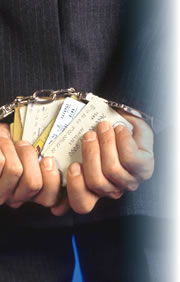The credit card regulation debate

When JPMorgan Chase revealed a $7 billion hole in one of its trading accounts, American Banker magazine noted: “The losses at JPMorgan, caused in part by a derivatives trader in London, have reignited debate about Dodd-Frank, which banks have been pushing back against since the law was passed in 2010.”
Even before the JP Morgan bombshell, most Americans were distinctly hostile to the idea that the country’s biggest financial institutions are over-regulated. On May 10, The Harris Poll published the results of a survey that revealed that 82 percent of respondents thought that “Wall Street should be subject to tougher regulation.” Just 15 percent disagreed with that proposition.
We may live in a democracy, but that doesn’t mean that the majority is always right. And, while it’s undeniable that those who advocate lighter regulation have suffered a serious blow as a result of JPMorgan’s problems, they’re far from down, let alone out. Indeed, some commentators are already arguing that the bank’s difficulties are a result of too much — rather than too little — regulation.
Credit card regulation not necessarily a model
Of course, the Dodd-Frank Act mostly relates to big issues in the banking sector. But can we learn anything about financial regulation in general from one small corner of the banking industry: credit cards? Well, it may be unwise to draw too many conclusions. After all, it proved impossible for the drafters of the Credit CARD Act of 2009 just to cap card fees in the way Congress intended (see Credit card watchdog dozes through daylight robbery).
The problem is, bad regulation can be worse than none. A couple of years ago, Robert L. Bradley, Jr. and Richard W. Fulmer wrote about how counterproductive it often is: “Any time government regulators try to do much more than lay out the basic rules of the game, unintended consequences and moral hazards rear their ugly heads.”
But credit card regulation works. Well, mostly.
And yet, many believe that credit card regulation is working well for consumers and credit card companies alike. Here are a selection of comments previously quoted on IndexCreditCards.com:
“The Act created a new equilibrium where interest rates have flattened, penalty charges have declined and a number of practices deemed “unfair or deceptive” have disappeared.” — Nick Bourke, director of The Pew Health Group’s Safe Credit Cards Project (quoted in Credit card law helps consumers, report says).
“Contrary to credit card industry claims, the new rules have not caused prices to increase or access to credit to fall. Instead, they have benefited the public by making credit card pricing significantly more transparent. Price transparency is likely to lower costs long term by spurring competition and making it harder for issuers to manipulate or arbitrarily raise prices.” — Center for Responsible Lending press release (quoted in Is credit card regulation working?).
“New federal rules barring many abusive practices by credit-card issuers seem to be having an effect: Only 12 percent of Americans said their credit-card companies had generally treated them unfairly, according to Consumer Reports’ nationwide survey, down from 15 percent in 2010, and 22 percent in 2009.” — ConsumerReports.org (quoted in CARD Act a win-win for credit card companies and customers).
Even the banking lobby has been forced to agree. In February last year, this site quoted Peter Garuccio of the American Bankers Association, who had then recently told USA Today: “…when you look at the regulations, it’s a net positive for consumers. But there have been some trade-offs.”
High credit card interest rates benefit nobody
In May, the Center for Responsible Lending (CRL) published a new report: Predatory Credit Card Lending: Unsafe, Unsound for Consumers and Companies. It found something quite remarkable: the more predatory credit card companies’ pricing policies – and the more aggressive their marketing strategies – were before the Great Recession, the greater their losses were during it. In other words, all those claims that high fees and credit card interest rates were supposed to mitigate risks were lies. According to the CRL’s report: “That’s because these fees and rates didn’t mitigate risk, they were the risk.”
So what may have looked during the good times as an effective way of milking consumers who might find themselves in extremis turned out to be the opposite. When faced with impossible credit card rates and fees, poor and desperate people had no choice but to default.
Credit card companies run by sentient beings?
There’s not much evidence that all credit card companies are run by people who “get” this sort of reality. All too many still seem to strain at the leash of regulation in the hope of breaking free. But the Credit CARD Act largely stops them, and in doing so may well be protecting them — as well as their customers — from their own wilder impulses.
Is this an argument for extending regulation further? It may well be that devising a system that prevents JPMorgan from blowing $7 billion is beyond the wit of man. But whether the government should try is a political decision that only you can make.
Disclaimer:The information in this article is believed to be accurate as of the date it was written. Please keep in mind that credit card offers change frequently. Therefore, we cannot guarantee the accuracy of the information in this article. Reasonable efforts are made to maintain accurate information. See the online credit card application for full terms and conditions on offers and rewards. Please verify all terms and conditions of any credit card prior to applying.
This content is not provided by any company mentioned in this article. Any opinions, analyses, reviews or recommendations expressed here are those of the author’s alone, and have not been reviewed, approved or otherwise endorsed by any such company. CardRatings.com does not review every company or every offer available on the market.
Published